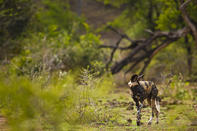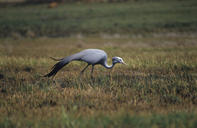Abundance of Natural Beauty
South Africa is blessed with various natural environments - lush indigenous forests, scenic mountain ranges, grasslands, wetlands, indigenous coastal fynbos and arid deserts. Because of its incredible biodiversity, the country is home to an abundance of beautiful wildlife.

The famous Big 5 mammals roam the savanna and bushveld areas, while the indigenous African wild dog and Springbok call the grass plains and Kalahari home. The Blue crane traverses the wetlands, while the Cape vulture makes a nest on high mountain ranges.
Unfortunately, many of South Africa’s wildlife face threats on a daily basis: loss of habitat due to agricultural practices, increased unnatural climate change, poaching and overgrazing are some of the dangers that various species come face-to-face with every day. It is thus of utmost importance that these animals and their natural environment be protected and conserved so that they don’t become extinct.
Animals Under Threat

Throughout the country, there are various nature and game reserves as well as conservancies that focus on protecting animals and their natural environment. Some institutions have partnered with wildlife organisations that are involved with the rehabilitation of endangered species, as well as the education of conservation and raising national awareness.
In KwaZulu-Natal, various efforts have been made to protect the endangered Blue crane, whose natural habitat of wetlands are under threat due to agricultural endeavours. Small pockets breeding pairs are found in the province, as well as in the Western Cape. The Endangered Wildlife Trust has an active African Crane Conservation Programme that aims to lessen the threats that face Blue cranes, as well as Wattled cranes, Grey crowned cranes and Black-crowned cranes.
In the Northern Cape, the arid Karoo region is home to the riverine rabbit, which is currently the most endangered mammal in South Africa. It only lives in the deep silt flood plains of seasonal Karoo rivers and can’t be found anywhere else in the world, making it incredibly vulnerable to habitat loss. The Endangered Wildlife Trust runs an active riverine rabbit conservation programme that protects the rabbit’s habitat, and they aim to get private landowners involved in the efforts to conserve the biodiversity of the Karoo.
In Mpumalanga and northern Eastern Cape, the endangered Yellow-breasted pipit lives in the highland grasslands of the Drakensberg and is under threat due to habitat loss from commercial livestock farming. The Natal Drakensberg Park and other nature reserves give the yellow-breasted pipit safe haven, and the Threatened Grassland Species Programme protects its habitat. Another animal found in the area is the Oribi, a beautiful antelope that faces the threat of illegal hunting. Oribi Working Group conserves its habitat and works to combat illegal hunting.
Rhinos are one of the most endangered mammals of South Africa. Small populations of this famous Big 5 member are found in the Mpumalanga, Limpopo, KwaZulu-Natal, Eastern Cape and Western Cape provinces in nature and game reserves. They are viciously hunted for their horns, and illegal poaching has become an increasing problem in the country. Another Big 5 animal sensitive to poaching is the African Elephant, who is also found in most provinces in larger numbers.
The African wild dog has been under threat due to negative misconceptions, and now there are only around 500 of them left in South Africa. They are conserved and protected in the Kruger National Park, where the Endangered Wildlife Trust has sponsored a major monitoring and reintroduction programme, as well as game reserves in the North West.
How Can You Help?

Although the Endangered Wildlife Trust is a large organisation, they run a tight operation with limited funds. People can donate financially to specific animal conservation programmes by visiting their website or specific organisations’ websites. Non-profit organisations like Save the Rhino and Save the African Wild Dog have partnered with commercial entities where you can donate locally as well. You can also become a beneficiary when you get a MyPlanet card (free of charge) that donates to organisations that protect species like the Oribi, Yellow-breasted pipit, Cape vulture and Golden mole.
Other than donating, people can offer their time by visiting various nature and game reserves that offer educational programs on protected and conserving South Africa’s most endangered species. You can spend time with the animals, get to know their habitat and learn what can be done to stop the destruction of their natural environment.
 In the 1800s, game was seen as a commodity, to be exploited for commercial gain. In the early 1900s, attitudes became more romantic, thanks ...
In the 1800s, game was seen as a commodity, to be exploited for commercial gain. In the early 1900s, attitudes became more romantic, thanks ... After James Steven Hamilton retired in 1946, the scientists broke into the mainstream. Dr R Bigalke of the National Zoological Gardens in Pr...
After James Steven Hamilton retired in 1946, the scientists broke into the mainstream. Dr R Bigalke of the National Zoological Gardens in Pr...